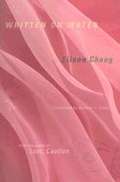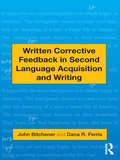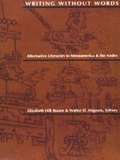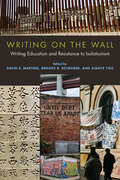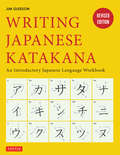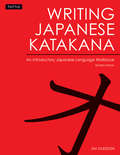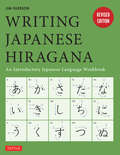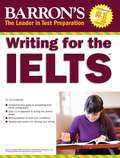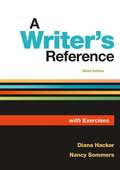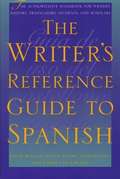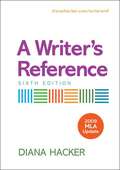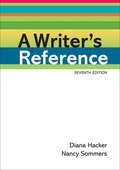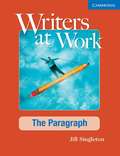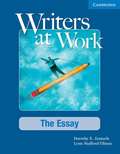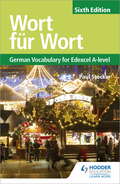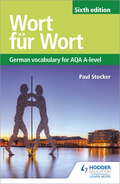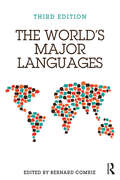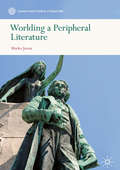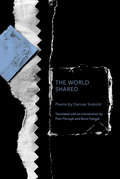- Table View
- List View
Written on Water
by Eileen Chang Andrew Jones Ailing Zhang Nicole HuangKnown as "the Garbo of Chinese letters" for her elegance and the aura of mystery that surrounded her, Eileen Chang is regarded as one of the greatest and most influential modern Chinese novelists and cultural critics of the twentieth century. In Written on Water, first published in 1945 and now available for the first time in English, Chang offers essays on art, literature, war, and urban life, as well as autobiographical reflections. Chang takes in the sights and sounds of wartime Shanghai and Hong Kong, with the tremors of national upheaval and the drone of warplanes in the background, and inventively fuses explorations of urban life, literary trends, domestic habits, and historic events. These evocative and moving firsthand accounts examine the subtle and not-so-subtle effects of the Japanese bombing and occupation of Shanghai and Hong Kong. Eileen Chang writes of friends, colleagues, and teachers turned soldiers or wartime volunteers, and her own experiences as a part-time nurse. Her nuanced depictions range from observations of how a woman's elegant dress affects morale to descriptions of hospital life. With a distinctive style that is at once meditative, vibrant, and humorous, Chang engages the reader through sly, ironic humor; an occasionally chatty tone; and an intense fascination with the subtleties of modern urban life. The collection vividly captures the sights and sounds of Shanghai, a city defined by its mix of tradition and modernity. Chang explores the city's food, fashions, shops, cultural life, and social mores; she reveals and upends prevalent attitudes toward women and in the process presents a portrait of a liberated, cosmopolitan woman, enjoying the opportunities, freedoms, and pleasures offered by urban life. In addition to her descriptions of daily life, Chang also reflects on a variety of artistic and literary issues, including contemporary films, the aims of the writer, the popularity of the Peking Opera, dance, and painting.
Written Corrective Feedback in Second Language Acquisition and Writing
by John Bitchener Dana R. FerrisWhat should language and writing teachers do about giving students written corrective feedback? This book surveys theory, research, and practice on the important and sometimes controversial issue of written corrective feedback, also known as “error/grammar correction,” and its impact on second language acquisition and second language writing development. Offering state-of-the-art treatment of a topic that is highly relevant to both researchers and practitioners, it critically analyzes and synthesizes several parallel and complementary strands of research — work on error/feedback (both oral and written) in SLA and studies of the impact of error correction in writing/composition courses — and addresses practical applications. Drawing from both second language acquisition and writing/composition literature, this volume is the first to intentionally connect these two separate but important lines of inquiry.
Writing Without Words: Alternative Literacies in Mesoamerica and the Andes
by Elizabeth Hill Boone Walter D. MignoloThe history of writing, or so the standard story goes, is an ascending process, evolving toward the alphabet and finally culminating in the "full writing" of recorded speech. Writing without Words challenges this orthodoxy, and with it widespread notions of literacy and dominant views of art and literature, history and geography. Asking how knowledge was encoded and preserved in Pre-Columbian and early colonial Mesoamerican cultures, the authors focus on systems of writing that did not strive to represent speech. Their work reveals the complicity of ideology in the history of literacy, and offers new insight into the history of writing.The contributors--who include art historians, anthropologists, and literary theorists--examine the ways in which ancient Mesoamerican and Andean peoples conveyed meaning through hieroglyphic, pictorial, and coded systems, systems inseparable from the ideologies they were developed to serve. We see, then, how these systems changed with the European invasion, and how uniquely colonial writing systems came to embody the post-conquest American ideologies. The authors also explore the role of these early systems in religious discourse and their relation to later colonial writing.Bringing the insights from Mesoamerica and the Andes to bear on a fundamental exchange among art history, literary theory, semiotics, and anthropology, the volume reveals the power contained in the medium of writing.Contributors. Elizabeth Hill Boone, Tom Cummins, Stephen Houston, Mark B. King, Dana Leibsohn, Walter D. Mignolo, John Monaghan, John M. D. Pohl, Joanne Rappaport, Peter van der Loo
Writing on the Wall: Writing Education and Resistance to Isolationism
by Xiaoye You David S. Martins Brooke R. SchreiberThe first concerted effort of writing studies scholars to interrogate isolationism in the United States, Writing on the Wall reveals how writing teachers—often working directly with students who are immigrants, undocumented, first-generation, international, and students of color—embody ideas that counter isolationism. The collection extends existing scholarship and research about the ways racist and colonial rhetorics impact writing education; the impact of translingual, transnational, and cosmopolitan ideologies on student learning and student writing; and the role international educational partnerships play in pushing back against isolationist ideologies. Established and early-career scholars who work in a broad range of institutional contexts highlight the historical connections among monolingualism, racism, and white nationalism and introduce community- and classroom-based practices that writing teachers use to resist isolationist beliefs and tendencies. “Writing on the wall” serves as a metaphor for the creative, direct action writing education can provide and invokes border spaces as sites of identity expression, belonging, and resistance. The book connects transnational writing education with the fight for racial justice in the US and around the world and will be of significance to secondary and postsecondary writing teachers and graduate students in English, linguistics, composition, and literacy studies. Contributors: Olga Aksakalova, Sara P. Alvarez, Brody Bluemel, Tuli Chatterji, Keith Gilyard, Joleen Hanson, Florianne Jimenez Perzan, Rebecca Lorimer Leonard, Layli Maria Miron, Tony D. Scott, Kate Vieira, Amy J. Wan
Writing Japanese Katakana
by Jim GleesonThis is an introductory guide and workbook to writing Japanese Katakana.Anybody who is able to master English, with its irregular spellings and idiosyncratic pronunciations, is more than equipped to master written Japanese. The hiragana and katakana syllabaries are purely phonetic characters, which function much like the letters of the English alphabet. In this respect, kana are quite different from kanji characters, which are based on Chinese ideographs and which represent ideas. The katakana syllabary is used primarily to represent borrowed words (from languages other than Chinese), although it is also used for botanical names and is sometimes used in place of hiragana or kanji for emphasis. In some ways, the use of katakana in Japanese parallels the use of italics in English.Writing practice is the most effective method of mastering written Japanese, and the large open format of this workbook is designed to invite the student to pick up a pencil and start writing. Written Japanese comprises two phonetic syllabaries, hiragana and katakana, and a set of kanji characters that are based on Chinese ideographs. This workbook has been carefully designed to facilitate the quick and easy mastery of the 46-character katakana alphabet, making it the perfect tool to begin the process of mastering written Japanese. Each character is introduced with brushed, handwritten and typed samples that enhance character recognition. Extensive space for writing allows maximum practice to facilitate memorization and to ensure proper character formation. Entertaining illustrations and amusing examples of loan-words that use katakana in Japanese writings further reinforce memorization in a fun way. Writing Katakana is tailored to the specific needs of young students of the Japanese language, but is also well suited to beginning students of any age. This workbook contains: grayed-out, trace-over characters for correct character construction. Extensive practice in writing sentences for maximum reinforcement. Supplementary explanations, including a brief history of the origin of each character, to foster visual recall.
Writing Japanese Katakana
by Jim GleesonThis is an introductory guide and workbook to writing Japanese Katakana.Anybody who is able to master English, with its irregular spellings and idiosyncratic pronunciations, is more than equipped to master written Japanese. The hiragana and katakana syllabaries are purely phonetic characters, which function much like the letters of the English alphabet. In this respect, kana are quite different from kanji characters, which are based on Chinese ideographs and which represent ideas. The katakana syllabary is used primarily to represent borrowed words (from languages other than Chinese), although it is also used for botanical names and is sometimes used in place of hiragana or kanji for emphasis. In some ways, the use of katakana in Japanese parallels the use of italics in English.Writing practice is the most effective method of mastering written Japanese, and the large open format of this workbook is designed to invite the student to pick up a pencil and start writing. Written Japanese comprises two phonetic syllabaries, hiragana and katakana, and a set of kanji characters that are based on Chinese ideographs. This workbook has been carefully designed to facilitate the quick and easy mastery of the 46-character katakana alphabet, making it the perfect tool to begin the process of mastering written Japanese. Each character is introduced with brushed, handwritten and typed samples that enhance character recognition. Extensive space for writing allows maximum practice to facilitate memorization and to ensure proper character formation. Entertaining illustrations and amusing examples of loan-words that use katakana in Japanese writings further reinforce memorization in a fun way. Writing Katakana is tailored to the specific needs of young students of the Japanese language, but is also well suited to beginning students of any age. This workbook contains:grayed-out, trace-over characters for correct character constructionExtensive practice in writing sentences for maximum reinforcementSupplementary explanations, including a brief history of the origin of each character, to foster visual recall.
Writing Japanese Katakana
by Jim GleesonThis is an introductory guide and workbook to writing Japanese Katakana.Anybody who is able to master English, with its irregular spellings and idiosyncratic pronunciations, is more than equipped to master written Japanese. The hiragana and katakana syllabaries are purely phonetic characters, which function much like the letters of the English alphabet. In this respect, kana are quite different from kanji characters, which are based on Chinese ideographs and which represent ideas. The katakana syllabary is used primarily to represent borrowed words (from languages other than Chinese), although it is also used for botanical names and is sometimes used in place of hiragana or kanji for emphasis. In some ways, the use of katakana in Japanese parallels the use of italics in English.Writing practice is the most effective method of mastering written Japanese, and the large open format of this workbook is designed to invite the student to pick up a pencil and start writing. Written Japanese comprises two phonetic syllabaries, hiragana and katakana, and a set of kanji characters that are based on Chinese ideographs. This workbook has been carefully designed to facilitate the quick and easy mastery of the 46-character katakana alphabet, making it the perfect tool to begin the process of mastering written Japanese. Each character is introduced with brushed, handwritten and typed samples that enhance character recognition. Extensive space for writing allows maximum practice to facilitate memorization and to ensure proper character formation. Entertaining illustrations and amusing examples of loan-words that use katakana in Japanese writings further reinforce memorization in a fun way. Writing Katakana is tailored to the specific needs of young students of the Japanese language, but is also well suited to beginning students of any age. This workbook contains:grayed-out, trace-over characters for correct character constructionExtensive practice in writing sentences for maximum reinforcementSupplementary explanations, including a brief history of the origin of each character, to foster visual recall.
Writing Japanese Hiragana
by Jim GleesonThis guide presents exercises, review practices and lively illustrations, helping the reader to learn to write Hiragana.
Writing Japanese Hiragana
by Jim GleesonPut simply, practice is the most effective method of mastering written Japanese. The large, open format of Writing Japanese Hiragana invites the student to pick up a pencil and get started!Two phonetic syllabaries, hiragana and katakana, and a set of kanji characters based on Chinese ideographs are what comprises written Japanese. This workbook has been carefully designed to facilitate the quick and easy mastery of the forty-six character hiragana syllabary used to write all types of native words not written in kanji. An understanding of hiragana is essential for the serious student wishing to learn Japanese effectively.Each character is introduced with brushed, handwritten, and typed samples which enhance character recognition. Extensive writing space allows for maximum practice to facilitate memorization and ensure proper character formation. Entertaining illustrations and amusing examples of onomatopoeic usage of hiragana in Japanese writings further reinforce memorization in a fun way.Writing Japanese Hiragana is an easy-to-use and practical workbook tailored to the specific needs of young students of the Japanese language. Beginning students of all ages will delight in its fresh presentation.
Writing Japanese Hiragana
by Jim GleesonPut simply, practice is the most effective method of mastering written Japanese. The large, open format of Writing Japanese Hiragana invites the student to pick up a pencil and get started!Two phonetic syllabaries, hiragana and katakana, and a set of kanji characters based on Chinese ideographs are what comprises written Japanese. This workbook has been carefully designed to facilitate the quick and easy mastery of the forty-six character hiragana syllabary used to write all types of native words not written in kanji. An understanding of hiragana is essential for the serious student wishing to learn Japanese effectively.Each character is introduced with brushed, handwritten, and typed samples which enhance character recognition. Extensive writing space allows for maximum practice to facilitate memorization and ensure proper character formation. Entertaining illustrations and amusing examples of onomatopoeic usage of hiragana in Japanese writings further reinforce memorization in a fun way.Writing Japanese Hiragana is an easy-to-use and practical workbook tailored to the specific needs of young students of the Japanese language. Beginning students of all ages will delight in its fresh presentation.
Writing for the IELTS
by Lin LougheedDiscover everything you’ll need to know in order to write well for the IELTS test, whether you are planning to take the Academic or the General Training version. This book will help IELTS test takers learn several essential skills, including:Task Achievement: follow a three-step model to plan, write, and revise your essaysCoherence and Cohesion: practice organizing your writing and connecting ideasLexical Resource: build your vocabulary and use it correctlyGrammatical Range and Accuracy: review rules and practice applying them to your writingEach section leads you step-by-step through the process of writing an essay in response to a particular task. Learn how to apply what you’ve learned, familiarize yourself with the types of questions you’ll have to respond to on the test, complete your responses within the time limits, and more. An Appendix also includes a More Writing Practice section with a selection of essays written in response to IELTS writing tasks.
A Writer's Reference With Exercises
by Diana Hacker Nancy SommersOur best selling classic tabbed handbook is available in a version that conveniently includes nearly one hundred integrated exercise sets for plenty of practice with the grammar, style, punctuation, and mechanics topics offered in the handbook. The answers to lettered items appear in the back of the book.
The Writer's Reference Guide to Spanish
by David William Foster Daniel Altamiranda Carmen De UriosteWriters and editors of Spanish have long needed an authoritative guide to written language usage, similar to The MLA Style Manual and The Chicago Manual of Style. And here it is! This reference guide provides comprehensive information on how the Spanish language is copyedited for publication. The book covers these major areas:- Language basics: capitalization, word division, spelling, and punctuation. - Language conventions: abbreviations, professional and personal titles, names of organizations, and nationalities. - Bibliographic format, particularly how Spanish differs from English. - Spanish language forms of classical authors' names. - Literary and grammatical terminology. - Linguistic terminology. - Biblical names and allusions. - A dictionary of grammatical doubts, including usage, grammatical constructions of particular words and phrases, verbal irregularities, and gender variations.
A Writer's Reference (6th Edition with 2009 MLA Update)
by Diana HackerRead this to find out more about the 2009 MLA updates and the 2010 APA updates. A Writer's Reference is the most widely adopted college handbook ever published. The new edition is available in a classic version that provides more help with academic writing, serves a wider range of multilingual students, and lends more support for college research -- all in an easy-to-use quick-reference format. Now for all the ways you teach your course, you can choose the classic version or choose from among 4 additional versions with varied content. A Writer's Reference with Exercises is tailor-made for classroom use or for additional grammar practice with 86 integrated exercise sets. A Writer's Reference with Writing in the Disciplines provides help for college writing beyond composition with advice and models in six academic disciplines. A Writer's Reference with Writing about Literature includes an entire tabbed section on interpreting and writing about works of literature, with two annotated student essays. A Writer's Reference with Extra Help for ESL Writers includes an entire tabbed section for nonnative speakers of English; it offers targeted advice and strategies for college writing and research.
A Writer's Reference
by Diana Hacker Nancy SommersA Writer's Reference, the most widely adopted handbook in the United States, continues to be groundbreaking in its simplicity, offering the right content in an accessible format. New coauthor Nancy Sommers's own research, campus travel, and classroom experience keep the handbook in tune with the needs of academic writers. In a trusted quick-reference format, the seventh edition delivers advice on all the right topics: working with sources, revising with comments, preparing a portfolio, and more. A Writer's Reference offers unprecedented flexibility with several versions to choose from -- a handbook that's truly at your service. Read the preface.
Writers at Work: The Paragraph
by Jill SingletonThe Writers at Work series prepares ESL students to tackle academic essay writing. Writers at Work: The Paragraph is designed for high-beginning to low-intermediate writing students. It uses personal topics such as "A Person Important to You" and "Holidays" to teach the basics of paragraph writing. A five-step process approach teaches students how to generate ideas, write a first draft, revise, edit, and self-evaluate their writing.
Writers at Work: The Essay
by Dorothy E. Zemach Lynn Stafford-YilmazThe Writers at Work series takes beginning to high intermediate-level writing students through a process approach to writing. The series is intended primarily for adults whose first language is not English, but it may also prove effective for younger writers or for native speakers of English who are developing their competence as independent writers in English.
Wort für Wort Sixth Edition: German Vocabulary for Edexcel A-level
by Paul StockerExam board: EdexcelLevel: A-levelSubject: GermanFirst teaching: September 2016First exams: Summer 2017Essential vocabulary for Edexcel A level German, all in one place.- Supplement key resources such as course textbooks with all the vocab students need to know in one easy-to-navigate place, completed updated to match the latest specification - Ensure extensive vocab coverage with topic-by-topic lists of key words and phrases, including a new section dedicated to film and literature - Test students' knowledge with end-of-topic activities designed to deepen their understanding of word patterns and relationships - Develop effective strategies for learning new vocab and dealing with unfamiliar words
Wort für Wort Sixth Edition: German Vocabulary for AQA A-level
by Paul StockerExam board: AQALevel: A-levelSubject: GeographyFirst teaching: September 2016First exams: Summer 2018Essential vocabulary for AQA A-level German, all in one place.- Supplement key resources such as course textbooks with all the vocab students need to know in one easy-to-navigate place, completed updated to match the latest specification - Ensure extensive vocab coverage with topic-by-topic lists of key words and phrases, including a new section dedicated to film and literature - Test students' knowledge with end-of-topic activities designed to deepen their understanding of word patterns and relationships - Develop effective strategies for learning new vocab and dealing with unfamiliar words
Wort für Wort Sixth Edition: German Vocabulary for AQA A-level
by Paul StockerExam board: AQALevel: A-levelSubject: GeographyFirst teaching: September 2016First exams: Summer 2018Essential vocabulary for AQA A-level German, all in one place.- Supplement key resources such as course textbooks with all the vocab students need to know in one easy-to-navigate place, completed updated to match the latest specification - Ensure extensive vocab coverage with topic-by-topic lists of key words and phrases, including a new section dedicated to film and literature - Test students' knowledge with end-of-topic activities designed to deepen their understanding of word patterns and relationships - Develop effective strategies for learning new vocab and dealing with unfamiliar words
Wort für Wort Sixth Edition: German Vocabulary for Edexcel A-level
by Paul StockerExam board: EdexcelLevel: A-levelSubject: GermanFirst teaching: September 2016First exams: Summer 2017Essential vocabulary for Edexcel A level German, all in one place.- Supplement key resources such as course textbooks with all the vocab students need to know in one easy-to-navigate place, completed updated to match the latest specification - Ensure extensive vocab coverage with topic-by-topic lists of key words and phrases, including a new section dedicated to film and literature - Test students' knowledge with end-of-topic activities designed to deepen their understanding of word patterns and relationships - Develop effective strategies for learning new vocab and dealing with unfamiliar words
The World's Major Languages
by Bernard ComrieThe World's Major Languages features over 50 of the world's languages and language families. This revised edition includes updated bibliographies for each chapter and up-to-date census figures. The featured languages have been chosen based on the number of speakers, their role as official languages and their cultural and historical importance. Each language is looked at in depth, and the chapters provide information on both grammatical features and on salient features of the language's history and cultural role. The World’s Major Languages is an accessible and essential reference work for linguists.
Worlding a Peripheral Literature (Canon and World Literature)
by Marko JuvanBringing together the analyses of the literary world-system, translation studies, and the research of European cultural nationalism, this book contests the view that texts can be attributed global importance irrespective of their origin, language, and position in the international book market. Focusing on Slovenian literature, almost unknown to world literature studies, this book addresses world literature’s canonical function in the nineteenth-century process of establishing European letters as national literatures. Aware of their dependence on imperial powers, (semi)peripheral national movements sought international recognition through, among other things, the newly invented figure of the national poet. Writers central to dependent national communities were canonized to represent their respective cultures to the norm-giving Other – the emerging world literary canon and its aesthetic ideology. Hence, national literatures asserted their linguo-cultural individuality through the process of worlding; that is, by their positioning in the international literary world informed by the supposed universality of the aesthetic.
The World Shared (Lannan Translations Selection Series)
by Dariusz SosnickiDariusz Sosnicki's poems open our eyes to the sublime just beneath the surface of the mundane: a train carrying children away from their parents for summer vacation turns into a ravenous monster; a meal at a Chinese restaurant inspires a surreal journey through the zodiac; a malfunctioning printer is a reminder of the ghosts that haunt us no matter where we find ourselves.Among the perpetrators and victims,buzzed or wasted to the bone,gliding without their blinkers onin the ruts of the national fate—they're not at home.Dariusz Sosnicki is an award-winning poet, essayist, and editor in Poland.
World Of Language
by Sandra Breuer Judy Brim Wendy DavisThe book that unlocks all imagination opening every mind to new and exciting ideas. World of language is a literature book that indeed enlarges your world to think, read, speak, listen and write.
